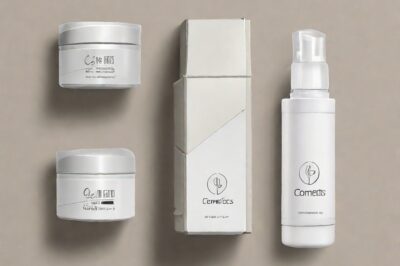The Rise of Biodegradable Cosmetics Packaging
In recent years, the beauty industry has witnessed a significant shift towards sustainability, with a growing emphasis on eco-friendly practices and products. One notable aspect of this movement is the rise of biodegradable cosmetics packaging. As consumers become more environmentally conscious, beauty brands are reevaluating their packaging choices to align with the principles of sustainability. In this article, we will explore the reasons behind the surge in popularity of biodegradable cosmetics boxes. Its environmental benefits, challenges faced by the industry, and the future outlook for sustainable beauty packaging.
Conventional Cosmetics Packaging
Traditional cosmetics packaging, often composed of plastic, has long been a major contributor to environmental degradation. The beauty industry’s reliance on non-biodegradable materials has led to overflowing landfills, pollution of water bodies, and harm to wildlife. Plastic packaging, in particular, poses a severe threat to the planet, as it can take hundreds of years to decompose. As consumers become more aware of these environmental issues, they are demanding change and holding beauty brands accountable for their ecological footprint.
Biodegradable Cosmetics Quality Packaging
In response to the environmental crisis, beauty brands are increasingly adopting biodegradable materials for their packaging. Biodegradable packaging refers to materials that can break down naturally into non-toxic components, leaving minimal environmental impact. The most common biodegradable materials include plant-based plastics, paper, cardboard, and even innovative options like mushroom-based packaging.
One of the driving forces behind the shift to biodegradable packaging is the desire to reduce the industry’s reliance on fossil fuels. Traditional plastics, derived from petroleum, are a finite resource with significant environmental consequences throughout their lifecycle. Biodegradable alternatives, often sourced from renewable materials, provide a sustainable solution that lessens the burden on the planet.
Benefits of Biodegradable Packaging
Reduced Plastic Pollution: Biodegradable packaging helps curb the plastic pollution crisis. Unlike traditional plastics that persist for centuries, biodegradable materials break down more quickly, minimizing their impact on ecosystems.
Lower Carbon Footprint: Many biodegradable packaging materials have a lower carbon footprint compared to their conventional counterparts. Manufacturing processes for biodegradable materials often involve fewer greenhouse gas emissions, contributing to overall environmental sustainability.
Renewable Resources: Plant-based plastics, a common biodegradable material, are derived from renewable resources such as sugarcane, corn, or cellulose. This contrasts sharply with traditional plastics, which rely on fossil fuels.
Soil Enrichment: Some biodegradable materials, like compostable packaging, can enrich soil as they decompose, acting as a natural fertilizer. This benefit adds an extra layer of environmental positivity to the use of biodegradable packaging.
Adoption of Biodegradable Quality Packaging
While the adoption of biodegradable cosmetics quality packaging is a positive step towards sustainability, the industry faces several challenges in its widespread implementation.
Cost Considerations: Biodegradable materials can be more expensive to produce than conventional packaging materials. This cost difference can be a barrier for some beauty brands, particularly smaller ones, that may struggle to absorb the increased expenses without passing them on to consumers.
Limited Options: Despite advancements in biodegradable materials, certain cosmetic products require specific packaging characteristics that may not be easily replicated with current biodegradable alternatives. This limitation poses a challenge for beauty brands seeking suitable packaging solutions for their diverse product lines.
Consumer Education: Some consumers may not fully understand the distinctions between biodegradable, compostable, and traditional packaging materials. Clear communication and education are crucial to ensure that consumers make informed choices and understand the environmental impact of their purchases.
Infrastructure Challenges: The successful decomposition of biodegradable materials often requires specific conditions, such as industrial composting facilities. In regions lacking these facilities, biodegradable packaging may not break down as efficiently, limiting its environmental benefits.
Consumer Awareness and the Demand for Sustainable Beauty
Consumer awareness plays a pivotal role in shaping the beauty industry’s transition towards sustainability. As more consumers prioritize eco-friendly practices in their purchasing decisions, beauty brands are compelled to align their values with those of their customers. The demand for biodegradable packaging reflects a broader cultural shift towards responsible consumption, where individuals seek products that not only enhance their beauty but also contribute positively to the planet.
Brands that demonstrate a commitment to environmental stewardship are gaining favor among consumers. Social media platforms amplify consumer voices, enabling them to hold brands accountable for their environmental practices. This increased transparency has pushed beauty companies to adopt sustainable packaging solutions as a strategic imperative to maintain and grow their customer base.
The Future Outlook for Sustainable Beauty Packaging
The momentum behind the adoption of biodegradable cosmetics packaging indicates a promising future for sustainable beauty practices. As technology continues to advance, more innovative and cost-effective biodegradable materials are likely to emerge, addressing current challenges and expanding the range of products suitable for sustainable packaging.
Government regulations and industry standards are also expected to evolve to encourage the adoption of sustainable packaging practices. Incentives for businesses that embrace eco-friendly alternatives and penalties for those that continue with environmentally harmful practices could further accelerate the industry’s transition towards sustainability.
Collaborations within the beauty industry and across sectors can drive research and development efforts, fostering the creation of new materials and technologies that meet the diverse needs of cosmetic packaging. Partnerships between beauty brands, packaging manufacturers, and environmental organizations can lead to comprehensive solutions that prioritize both product performance and environmental responsibility.
Conclusion
The rise of biodegradable best packaging marks a significant stride towards a more sustainable and responsible beauty industry. As consumers become increasingly conscious of their ecological impact, beauty brands are reevaluating their packaging. While challenges exist, the industry is making notable progress, with innovations in materials and sustainable packaging. The shift towards biodegradable packaging not only benefits the environment. Its also reflects a broader cultural shift towards a more mindful and responsible approach to beauty. As the beauty industry continues to evolve, the adoption of sustainable practices, including biodegradable packaging, of the modern beauty landscape.
